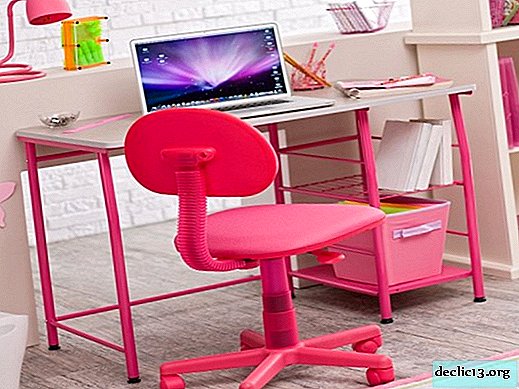All about bush rose in a pot. Features of the flower, the rules of growing and caring at home

To observe the flowering of roses on your windowsill at any time of the year is the dream of every housewife.
Despite the difficulty in care, indoor rose is becoming more and more popular every year.
And this is right - after all, with a caring florist, a spray rose will delight the eyes of friends of loved ones for many years.
In this article we will tell you all the nuances of caring for a room rose, how to grow it correctly and what difficulties may arise.
Botanical Description
Indoor rose, like garden counterparts, has thick stems with spikes, hard carved dark green leaves. The shape, color and size of the bud vary, depending on the variety of plant.
Features
A distinctive feature of a room rose is its small size - it does not exceed 50 cm in height. In addition, a specific feature of this plant species is the method of reproduction.
It is important that the rose was grown from the cuttings, and not grafted, as the latter rarely survive at home.Pros and Cons of Growing a Potted Flower
Growing this plant in an apartment has a large number of positive aspects.:
 Year-round flowering. With proper care, you can enjoy the pink buds in winter and summer. It must be remembered that some varieties require a short rest between blossoms.
Year-round flowering. With proper care, you can enjoy the pink buds in winter and summer. It must be remembered that some varieties require a short rest between blossoms.- Compact size. The convenient dimensions of the plant itself and its root system allow you to keep the rose in a small pot on the windowsill.
- Since the bush rose is one of the varieties of garden, if desired, it can be transplanted to the site where it will continue to delight the eyes of others.
But there is also disadvantages you need to know before purchasing a room rose:
- Difficulty in care. The plant is quite whimsical and sensitive to excess or lack of sunlight, moisture, temperature changes. It requires careful care and care.
- The need for a "dream". Some varieties of spray roses need to arrange breaks between blossoms, during which the plant must be kept in special conditions.
- Low or no aroma. Unlike fragrant garden brothers, the smell of most varieties of indoor roses is weak and almost imperceptible.
Brief History of Origin
In classical gardening literature, China is indicated as the place of origin of the indoor rose. However, some authors speak of Southeast Asia and Europe as the birthplace of this plant.
How to grow at home in pots?
Landing
- Planting a plant from a transport to a permanent pot should be no earlier than two weeks after acquisition. This is due to the need to adapt the roses to new conditions.
- The pot itself should not be too large - the ground, not braided by roots, is acidified, which leads to decay of the root system. Optimal for each transplant will be an increase in capacity by 2 cm in diameter and 5-6 cm in depth.
 The soil must be loose and nutritious. A combination of peat, sand and chernozem is most suitable for a rose. The best option is to purchase a special garden mix for growing bush roses, but you can prepare the soil yourself. In this case, it is taken:
The soil must be loose and nutritious. A combination of peat, sand and chernozem is most suitable for a rose. The best option is to purchase a special garden mix for growing bush roses, but you can prepare the soil yourself. In this case, it is taken:- 15% sand;
- 20% black soil;
- 25% peat.
The remaining mass is gained by humus and garden soil.
- The soil is thoroughly mixed and moistened with warm water before planting.
To facilitate adaptation, roses can be replanted with an earthen lump braided by the root system, and the remaining space in the pot should be filled with fresh earthen mixture. This reduces the likelihood of damaging the roots, and the plant gradually gets used to the new soil.
How to care?
You should carefully and scrupulously approach the study of the rules for growing bush roses, since this plant loves care and attention. With the right approach, the chores of caring for a room rose will pay off in full with its magnificent flowering.
Conditions of detention
- A place. A room rose loves free space, so it is worth placing it so that it does not come in contact with other plants leaves. It would be best to put a bush rose on the south window or next to it.
Rosa needs constant access to fresh air, but drafts must be avoided.
- Temperature. Rosa is thermophilic, but sensitive to excessively hot climates; therefore, the optimum temperature during growth and flowering will be + 14 ... + 25 ° С. During the rest period, the temperature in the room with the rose should not exceed + 5 ... + 8 ° С.
- Humidity. It is important to ensure sufficient moisture not only in the soil, but also in the air for the rose. To do this, 2-3 times a week, and in hot, dry weather daily, spray the leaves with warm, settled water. During sleep, sprinkling is reduced.
- Lighting. The plant needs a lot of sunlight, which is why it is recommended to place it on the south window or balcony. With increased solar activity, you can shade the plant to avoid leaf burns, but do not abuse it.
 Watering. A growing and blooming rose is watered often, daily or every other day, especially in the hot season. It is best to water in small portions, since the rose is very sensitive to excess moisture. It is necessary to ensure that excess moisture does not accumulate in the pan and immediately remove it. Watered a bush rose with warm, settled water in the evening. At rest, the flower is watered very rarely, only to prevent the root system from drying out.
Watering. A growing and blooming rose is watered often, daily or every other day, especially in the hot season. It is best to water in small portions, since the rose is very sensitive to excess moisture. It is necessary to ensure that excess moisture does not accumulate in the pan and immediately remove it. Watered a bush rose with warm, settled water in the evening. At rest, the flower is watered very rarely, only to prevent the root system from drying out.- Top dressing. During active growth, you can feed the plant every 2 weeks, using special additives designed for indoor shrub roses. During dormancy, fertilize the rose once a month.
- Pruning. Circumcision is performed when preparing the rose for the period of "sleep". To do this, remove all weak and dried branches, each shoot is shortened, leaving 5-6 buds. If pruning is not carried out, over time the shoots will stretch, they will look sloppy, and flowering will become poorer.
- Transfer. Transplanting is another procedure when preparing a rose for wintering and is carried out annually after pruning. The pot into which the plant is moved should be 2 cm larger in diameter and 5-6 cm higher than the previous one. The rose is transplanted together with an earthen lump from an old pot, as during the first landing.
- Pest and Disease Prevention. To prevent the occurrence of diseases of room roses, you must carefully take care of the microclimate conditions necessary for this plant. Most rose diseases result from improper care.
Breeding
The easiest way to propagate a bush indoor rose is cuttings. For this:
- A branch with a formed bud is selected and a stalk 15-30 cm long is cut. The cut angle should be minimal.
- Excess leaves and flowers are removed from the branch.
- Slices of the cuttings and the mother bush are treated with a solution of potassium permanganate,
- Then, the cut process is soaked in a root solution during the day.
- Cuttings are planted in prepared loose soil, deepening so much that the upper kidney is above the ground.
- Sprinkle and spray the plant daily, but not too abundantly.
- To create a greenhouse effect, the sprout is covered with a dome. It is made from the cropped top of the bottle with a screw cap for airflow. The dome is removed with the appearance of the first leaves.
Diseases and Pests
 Spider mite. This is a microscopic parasite that multiplies actively in a dry and hot climate. A characteristic cobweb appears on the bush, young plants are especially susceptible. To destroy this pest, insecticides are used, such as Fitoverm, Fufanon, Actellik. They process all the plants in the house, three times, with an interval of 10-12 days.
Spider mite. This is a microscopic parasite that multiplies actively in a dry and hot climate. A characteristic cobweb appears on the bush, young plants are especially susceptible. To destroy this pest, insecticides are used, such as Fitoverm, Fufanon, Actellik. They process all the plants in the house, three times, with an interval of 10-12 days.- Powdery mildew. It occurs during heavy watering, keeping roses in cold, unventilated rooms with high humidity. The leaves of the plant are covered with a whitish coating, dry and fall off. To treat the disease, the bushes are treated with copper sulfate or colloidal sulfur, the affected parts of the plant must be removed.
- Rust. Appears with a disturbed ratio of mineral components in the soil of the plant. In this case, brown spots are found on the leaves, the growth of the bush slows down. This problem is treated by treating the plant with iron sulfate, Bordeaux liquid, or copper chloroxide.
You can see more details about pests of indoor roses and their control in the video below:
Mistakes in leaving
Rose is a rather finicky plant and any error in caring for it can lead to unpleasant consequences.We will analyze most common mistakes:
- Excessive watering and spraying, keeping in a cold room lead to decay of the roots and death of the plant.
- A sharp change in ambient temperature, frequent transfer from one place to another cause stressful dropping of leaves.
- Not carrying out the necessary procedures for wintering - pruning and replanting - slows down or stops the growth and flowering of roses.
- Low humidity and insufficient watering lead to drying of leaves and buds and their falling.
To correct the above errors and prevent the death of the plant, it is necessary to normalize the microclimate in which the rose is located, and carefully follow all the care recommendations described in this article.
Indoor spray rose - a beautiful plant that delights the eyes of its owners blooming buds at any time of the year. However, it should be remembered that this flower is quite difficult to care for and with a responsibility to approach its acquisition.

 Year-round flowering. With proper care, you can enjoy the pink buds in winter and summer. It must be remembered that some varieties require a short rest between blossoms.
Year-round flowering. With proper care, you can enjoy the pink buds in winter and summer. It must be remembered that some varieties require a short rest between blossoms. The soil must be loose and nutritious. A combination of peat, sand and chernozem is most suitable for a rose. The best option is to purchase a special garden mix for growing bush roses, but you can prepare the soil yourself. In this case, it is taken:
The soil must be loose and nutritious. A combination of peat, sand and chernozem is most suitable for a rose. The best option is to purchase a special garden mix for growing bush roses, but you can prepare the soil yourself. In this case, it is taken: Watering. A growing and blooming rose is watered often, daily or every other day, especially in the hot season. It is best to water in small portions, since the rose is very sensitive to excess moisture. It is necessary to ensure that excess moisture does not accumulate in the pan and immediately remove it. Watered a bush rose with warm, settled water in the evening. At rest, the flower is watered very rarely, only to prevent the root system from drying out.
Watering. A growing and blooming rose is watered often, daily or every other day, especially in the hot season. It is best to water in small portions, since the rose is very sensitive to excess moisture. It is necessary to ensure that excess moisture does not accumulate in the pan and immediately remove it. Watered a bush rose with warm, settled water in the evening. At rest, the flower is watered very rarely, only to prevent the root system from drying out. Spider mite. This is a microscopic parasite that multiplies actively in a dry and hot climate. A characteristic cobweb appears on the bush, young plants are especially susceptible. To destroy this pest, insecticides are used, such as Fitoverm, Fufanon, Actellik. They process all the plants in the house, three times, with an interval of 10-12 days.
Spider mite. This is a microscopic parasite that multiplies actively in a dry and hot climate. A characteristic cobweb appears on the bush, young plants are especially susceptible. To destroy this pest, insecticides are used, such as Fitoverm, Fufanon, Actellik. They process all the plants in the house, three times, with an interval of 10-12 days.















